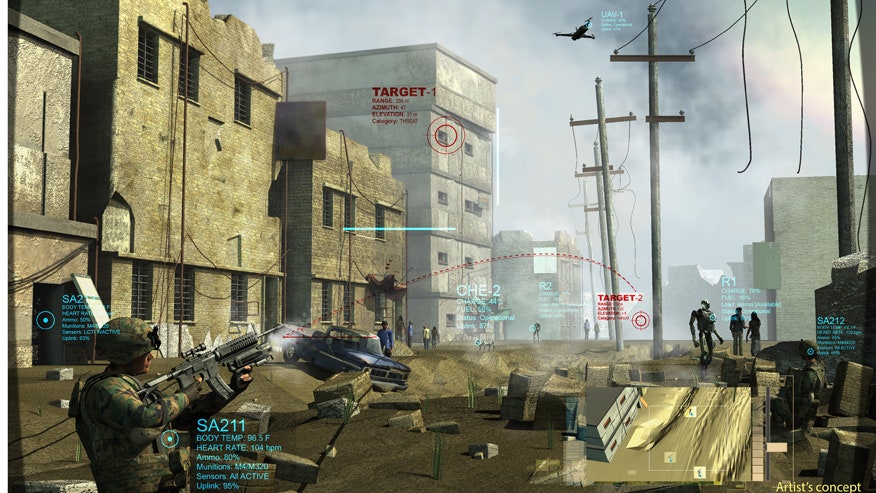
DARPA’s new Squad X Core Technologies (SXCT) program aims to help dismounted infantry squads continue to achieve and maintain overwhelming tactical superiority over potential adversaries. (DARPA)
Military ‘X-Men’
Squad X Core will take the amazing advanced capabilities in U.S. military ships, aircraft and ground vehicles and put those tech advantages directly into the hands of dismounted infantry squads.
The Department of Defense’s innovative agency DARPA is aiming to build combat power from the rifle squad up with the Squad X Core Technologies program (SXCT). By putting state of the art tech advances into the hands of US infantry squads, it will revolutionize their capabilities.
Overall, the new tech should help squads be flexible and adapt rapidly to challenging complex environments and the wide range of requirements under evolving operational demands. It will help squads shape the battlespace, or a unified military strategy, and dominate it.
Without any cumbersome and heavy hardware, SXCT intends to ensure dismounted infantry squads achieve overwhelming tactical superiority over adversaries.
How is this different?
Currently, warfighters benefit from amazing tech advances in places like their ships, aircraft and ground vehicles. While there, they can leverage the crucial advantages these kinds of technological innovations provide from precision armaments to comprehensive next generation situational awareness.
But lots of this ultra-advanced tech requires hefty scale equipment in size, weight, and power to deliver these advantages.
Givens standard military equipment’s bulky, sometimes massive dimensions, just handing this technology to dismounted warfighters is not an option. In general, soldiers have to carry over 100 pounds of gear. Currently, research is being conducted to find ways to reduce this burden. For soldiers on the ground, carrying this excess weight can cause fatigue and intense physical strain. In fact, physical overburden is listed as one of the Army’s top five science and technology challenges faced by soldiers.
To lessen this physical burden on troops, the SXCT program aims to give troops advanced, yet still lightweight, equipment.
The program doesn’t just physically streamline the equipment – soldiers and marines using this tech will be able to more intuitively understand and control their mission environments.
Small units will have adapted and extended real-time situational awareness and the ability to precisely verify and engage hostile targets at multiple ranges.
“SXCT aims to help dismounted infantry squads have deep awareness of what’s around them, detect threats from farther away and, when necessary, engage adversaries more quickly and precisely than ever before,” said DARPA program manager Maj. Christopher Orlowski in the program announcement.
Maj. Orlowski’s experience includes deployment to Operation Iraqi Freedom as a tank platoon leader and two years as the commander of a recruiting company. Orlowski joined DARPA in March 2014 after serving at the Robotic Systems Joint Project Office.
Orlowski added “We are working towards advanced capabilities that would make dismounted infantry squads more adaptable, safe and effective.”
Four key advances
The program is looking at four key military tech advances –precision engagement, non-kinetic engagement, squad sensing, and squad autonomy.
In the precision engagement arm of the program, the aim is to allow warfighters to precisely engage threats out to six tenths of a mile.
So, what is the overall goal? The answer: Give squads state of the art guided effects that will allow them to dominate the battlefield.
The second aim of the program is to provide tech to disrupt enemy operations. For example, this could be used against enemy command, control, and communications. This is known as “non-kinetic engagement.”
Some tech in this component will also disrupt enemy use of unmanned vehicles or drones. The key here is that squads will be able to use this tech while on the move and still maintain an operational pace with occasional bursts of speed when necessary.
The squad sensing advances will allow warfighters to detect potential threats out to 0.6 mile away while also on the move at an operational pace. The tech will include next-gen fusion and exploitation of real time data to greatly enhance a squad’s situational awareness of threats in their environment.
The final component of SXCT is tech that focuses on squad autonomy. This new tech will further enhance a warfighter’s awareness of his location and that of teammates. It will be so exact that it will be accurate to less than 20 feet in real time. Another key advantage – it will provide this data in environments where GPS is denied.
And here’s a very cool twist — it is expected to provide enhanced location accuracy despite faulty GPS coordinates by syncing with embedded unmanned air and ground systems. The unmanned systems — like aerial drones — would work in tandem with the human squad.
Other unmanned systems could be something like DARPA’s four-legged robot known as Legged Squad Support System (LS3).
Similar to a trained military animal, this robot is designed to integrate and act as part of the team, with a squad of soldiers. The robot will be able to carry 400 pounds of a human squad’s load, keep up with squad members through tough rugged terrain, and also interact with warfighters naturally.
What’s next?
The program will be a multi-year, multi-phase technology development program.
DARPA is keen to encourage innovative proposals from non-traditional sources like small businesses, academic and research institutions, and first-time government contractors.
DARPA is hosting a Proposers Day on Friday, Feb. 27, 2015. Advanced registration is required and is available at https://safe.sysplan.com/confsys/squadx and closes when capacity is reached.
Ballet dancer turned defense specialist Allison Barrie has traveled around the world covering the military, terrorism, weapons advancements and life on the front line. You can reach her at wargames@foxnews.com or follow her on Twitter @Allison_Barrie.

